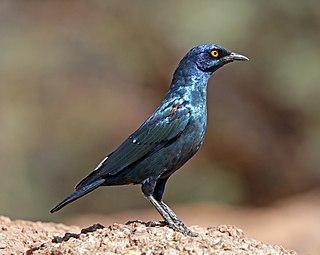
Starlings are small to medium-sized passerine birds in the family Sturnidae. The name "Sturnidae" comes from the Latin word for starling, sturnus. Many Asian species, particularly the larger ones, are called mynas, and many African species are known as glossy starlings because of their iridescent plumage. Starlings are native to Europe, Asia and Africa, as well as northern Australia and the islands of the tropical Pacific. Several European and Asian species have been introduced to these areas as well as North America, Hawaii and New Zealand, where they generally compete for habitats with native birds and are considered to be invasive species. The starling species familiar to most people in Europe and North America is the common starling, and throughout much of Asia and the Pacific, the common myna is indeed common.

The long-tailed glossy starling is a member of the starling family of birds. It is a resident breeder in tropical Africa from Senegal east to Sudan.

The purple starling, also known as the purple glossy starling, is a member of the starling family of birds.

The superb starling is a member of the starling family of birds. It was formerly known as Spreo superbus.

Fischer's lovebird is a small parrot species of the genus Agapornis. They were originally discovered in the late 19th century. They are named after German explorer Gustav Fischer.

The golden-breasted starling, also known as royal starling, is a medium-sized passerine in the starling family.

Lamprotornis is a large genus of glossy-starlings all of which occur in Africa south of the Sahara. They have glossy blue or green upper parts, which is due to hollow melanin granules arranged in a single layer near the feather barbule's surface. This unique arrangement led to some glossy starlings formerly placed in the genus Spreo being transferred to Lamprotornis, since they shared this feature.

The emerald starling is also known as the iris glossy starling. It is a small starling with a metallic green crown, upper body, wings and tail. The ear-coverts and underparts are metallic purple. Both sexes are similar. Most taxonomists unite it with many other glossy starlings in Lamprotornis, while others place it in a monotypic genus Coccycolius.

The pied starling or African pied starling is a bird endemic to South Africa, Lesotho and Eswatini. It is common in most of its range, but largely absent from the arid northwest and the eastern lowlands of South Africa. It is found in open habitats such as grassland, karoo scrub, thornbush and agricultural land, and often associates with farm animals.

The wattled starling is a nomadic resident bird in eastern and southern Africa. It is a species of grassland, open woodland, and cultivation.

The greater blue-eared starling or greater blue-eared glossy-starling is a bird that breeds from Senegal east to Ethiopia and south through eastern Africa to northeastern South Africa and Angola. It is a very common species of open woodland bird, and undertakes some seasonal migration.

Hildebrandt's starling is a species of starling in the family Sturnidae. It forms a superspecies with and has previously been included in the same species as Shelley's starling, a migratory species ranging from Ethiopia and Somalia to Kenya. Both of these species have also been combined into a superspecies with the chestnut-bellied starling of West Africa. It was originally placed in the now defunct genus Notauges. The species is named for Johann Maria Hildebrandt, a German collector who was the first European to obtain specimens.

Meves's starling or Meves's glossy-starling, is a species of starling in the family Sturnidae. It is found in Angola, Botswana, Malawi, Mozambique, Namibia, South Africa, Zambia, and Zimbabwe.

The Cape starling, also known as red-shouldered glossy-starling or Cape glossy starling, is a species of starling in the family Sturnidae. It is found in Southern Africa, where it lives in woodlands, bushveld and in suburbs.

The yellow-faced myna is a species of starling in the family Sturnidae. It is found in New Guinea and nearby smaller islands, where its natural habitat is subtropical or tropical moist lowland forests. The long-tailed myna was formerly included as a subspecies. One of the largest species of starling, this species attains 23 to 26 cm in length and weighs around 217 g (7.7 oz). They have dark plumage with a metallic lustre and bright orange facial markings and beak. These birds are social and omnivorous. Their diet consists of fruit and insects for which they forage high in the canopy. They are common birds with a wide range, and the International Union for Conservation of Nature has assessed their conservation status as being of "least concern".

Fischer's turaco is a species of bird in the family Musophagidae. It is found in Coastal East Africa, including Kenya, Somalia, and Tanzania. Its natural habitats are subtropical or tropical moist lowland forest, subtropical or tropical moist montane forest, and arable land. It is threatened by habitat loss and trapping for the wildlife trade.

















